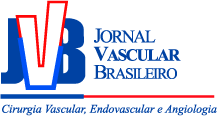Relationships between severity of signs and symptoms and quality of life in patients with chronic venous disease
Estudo da relação entre a gravidade dos sinais, dos sintomas e da qualidade de vida em pacientes portadores de doença venosa crônica
Fabio Henrique Rossi; Marília Granzotto Volpato; Patrick Bastos Metzger; Camila Baumann Beteli; Bruno Lourenção de Almeida; Cybelle Bossolani Onofre Rossi; Nilo Mitsuru Izukawa
Abstract
Keywords
Resumo
Palavras-chave
References
Heit JA, Rooke TW, Silverstein MD, Mohr DN, Lohse CM, Petterson TM. Trends in the incidence of venous stasis syndrome and venous ulcer: a 25-year population-based study. J Vasc Surg.. ;33(5):1022-027.
Maffei FH, Magaldi C, Pinho SZ, Lastoria S, Pinho W, Yoshida WB. Varicose veins and chronic venous insufficiency in Brazil: prevalence among 1755 inhabitants of a country town. Int J Epidemiol.. ;15(2):210-17.
Silva MC. Chronic venous insufficiency of the lower limbs and its socio-economic significance. Int Angiol.. ;10(3):152-57.
Rabe E, Pannier F. Societal costs of chronic venous disease in CEAP C4, C5, C6 disease. Phlebology.. ;25(Suppl 1):64-7.
Castro AA, Santos M. ALS C, Teixeira AR. Diagnóstico e tratamento da doença venosa crônica. J Vasc Bras.. ;4(Supl 2):S185-S194.
Lozano Sánchez FS, Sánchez Nevarez I, González-Porras JR, Marinello Roura J, Escudero Rodríguez JR, Díaz Sánchez S. Quality of life in patients with chronic venous disease: influence of the socio-demographical and clinical factors. Int Angiol.. ;32(4):433-41.
Kibbe MR, Ujiki M, Goodwin AL, Eskandari M, Yao J, Matsumura J. Iliac vein compression in an asymptomatic patient population. J Vasc Surg.. ;39(5):937-43.
Lamping DL. Measuring health-related quality of life in venous disease: practical and scientific considerations. Angiology.. ;48(1):51-7.
Garratt AM, Ruta DA, Abdalla MI, Russell IT. Responsiveness of the SF-36 and a condition-specific measure of health for patients with varicose veins. Qual Life Res.. ;5(2):223-34.
Launois R, Reboul-Marty J, Henry B. Construction and validation of a quality of life questionnaire in chronic lower limb venous insufficiency (CIVIQ). Qual Life Res.. ;5(6):539-54.
Kurz X, Lamping DL, Kahn SR, Baccaglini U, Zuccarelli F, Spreafico G. Do varicose veins affect quality of life? Results of an international population-based study. J Vasc Surg.. ;34(4):641-48.
Andreozzi GM, Cordova RM, Scomparin A, Martini R, D'Eri A, Andreozzi F. Quality of life in chronic venous insufficiency. An Italian pilot study of the Triveneto Region. Int Angiol.. ;24(3):272-77.
Chiesa R, Marone EM, Limoni C, Volonté M, Schaefer E, Petrini O. Effect of chronic venous insufficiency on activities of daily living and quality of life: correlation of demographic factors with duplex ultrasonography findings. Angiology.. ;58(4):440-49.
Santos RFFN, Porfírio GJM, Pitta GBB. A diferença na qualidade de vida de pacientes com doença venosa crônica leve e grave. J Vasc Bras.. ;8(2):143-47.
Bradbury A, Evans C, Allan P, Lee A, Ruckley CV, Fowkes FG. What are the symptoms of varicose veins? Edinburgh vein study cross sectional population survey. BMJ.. ;318(7180):353-56.
Garratt AM, Macdonald LM, Ruta DA, Russell IT, Buckingham JK, Krukowski ZH. Towards measurement of outcome for patients with varicose veins. Qual Health Care.. ;2(1):5-10.
Smith JJ, Garratt AM, Guest M, Greenhalgh RM, Davies AH. Evaluating and improving health-related quality of life in patients with varicose veins. J Vasc Surg.. ;30(4):710-19.
Baker DM, Turnbull NB, Pearson JC, Makin GS. How successful is varicose vein surgery? A patient outcome study following varicose vein surgery using the SF-36 Health Assessment Questionnaire. Eur J Vasc Endovasc Surg.. ;9(3):299-304.
Eklöf B, Rutherford RB, Bergan JJ, Carpentier PH, Gloviczki P, Kistner RL. Revision of the CEAP classification for chronic venous disorders: consensus statement. J Vasc Surg.. ;40(6):1248-252.
Scott J, Huskisson EC. Graphic representation of pain. Pain.. ;2(2):175-84.
Jensen MP, Karoly P, Braver S. The measurement of clinical pain intensity: a comparison of six methods. Pain.. ;2(2):185-90.
Rutherford RB, Padberg FT Jr, Comerota AJ, Kistner RL, Meissner MH, Moneta GL. Venous severity scoring: An adjunct to venous outcome assessment. J Vasc Surg.. ;31(6):1307-312.
Passman MA, McLafferty RB, Lentz MF, Nagre SB, Iafrati MD, Bohannon WT. Validation of Venous Clinical Severity Score (VCSS) with other venous severity assessment tools from the American Venous Forum, National Venous Screening Program. J Vasc Surg.. ;54(S):2S-9S.
Gloviczki P, Comerota AJ, Dalsing MC, Eklof BG, Gillespie DL, Gloviczki ML, et al. The care of patients with varicose veins and associated chronic venous diseases: clinical practice guidelines of the Society for Vascular Surgery and the American Venous Forum. J Vasc Surg.. ;53(5):2S-48S.
Howlader MH, Smith PDC. Symptoms of chronic venous disease and association with systemic inflammatory markers. J Vasc Surg.. ;38(5):950-54.
Kaplan RM, Criqui MH, Denenberg JO, Bergan J, Fronek A. Quality of life in patients with chronic venous disease: San Diego population study. J Vasc Surg.. ;37(5):1047-053.
Vasquez MA, Rabe E, McLafferty RB, Shortell CK, Marston WA, Gillespie D. Revision of the venous clinical severity score: venous outcomes consensus statement: special communication of the American Venous Forum Ad Hoc Outcomes Working Group. J Vasc Surg.. ;52(5):1387-396.
Padberg FT Jr, Maniker AH, Carmel G, Pappas PJ, Silva MB Jr, Hobson RW 2nd. Sensory impairment: a feature of chronic venous insufficiency. J Vasc Surg.. ;30(5):836-42.
Reinhardt F, Wetzel T, Vetten S, Radespiel-Tröger M, Hilz MJ, Heuss D. Peripheral neuropathy in chronic venous insufficiency. Muscle Nerve.. ;23(6):883-87.
Zubieta JK, Heitzeg MM, Smith YR, Bueller JA, Xu K, Xu Y. COMT val158met genotype affects mu-opioid neurotransmitter responses to a pain stressor. Science.. ;299(5610):1240-243.
Holthusen H. Involvement of the NO/cyclic GMP pathway in bradykinin-evoked pain from veins in humans. Pain.. ;69(1-2):87-92.
Raffetto JD. Inflammation in chronic venous ulcers. Phlebology.. ;28(Suppl 1):61-7.
Kaplan RM, Criqui MH, Denenberg JO, Bergan J, Fronek A. Quality of life in patients with chronic venous disease: San Diego population study. J Vasc Surg.. ;37(5):1047-053.



